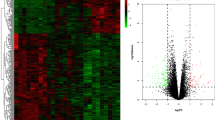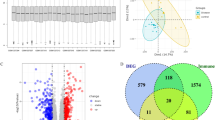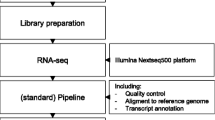Abstract
Purpose
The purpose of this study was to identify a biomarker that can predict the efficacy of rituximab (RTX) in the treatment of rheumatoid arthritis (RA) patients.
Methods
Utilized weighted gene co-expression network analysis (WGCNA) and LASSO regression analysis of whole blood transcriptome data (GSE15316 and GSE37107) related to RTX treatment for RA from the GEO database, the critical modules, and key genes related to the efficacy of RTX treatment for RA were found. The biological functions were further explored through enrichment analysis. The area under the ROC curve (AUC) was validated using the GSE54629 dataset.
Results
WGCNA screened 71 genes for a dark turquoise module that were correlated with the efficacy of RTX treatment for RA (r = 0.42, P < 0.05). Through the calculation of gene significance (GS) and module membership (MM), 12 important genes were identified; in addition, 21 important genes were screened by the LASSO regression model; two key genes were obtained from the intersection between the important genes. Then, BANK1 (AUC = 0.704, P < 0.05) was identified as a potential biomarker to predict the efficacy of RTX treatment for RA by ROC curve evaluation of the treatment and validation groups. BANK1 gene expression was significantly decreased after RTX treatment, and a statistically significant difference was found (log FC = − 2.08, P < 0.05). Immune cell infiltration analysis revealed that the infiltration of CD4 + T cell memory subset was increased in the group with high BANK1 expression, and a statistically significant difference was found (P < 0.05).
Conclusions
BANK1 can be used as a potential biomarker to predict the response of RTX treatment in RA patients.
Key Points • Identifying the hub genes BANK1 as a potential biomarker to predict the response of RTX treatment in RA patients and confirming it in validation data. • Using the WGCNA approach and LASSO analyses to identify the BANK1 in a data set consisting of two GEO data merged and assessing the correlations between BANK1 and immune infiltration by CIBERSORT algorithm. |






Similar content being viewed by others
References
Smolen JS, Aletaha D, McInnes IB (2016) Rheumatoid arthritis [published correction appears in Lancet. Lancet 388(10055):2023–2038. https://doi.org/10.1016/S0140-6736(16)30173-8
Fiehn C (2022) Biologikatherapie von rheumatoider Arthritis und Spondyloarthritiden [Treatment of rheumatoid arthritis and spondylarthritis with biologics]. Internist (Berl) 63(2):135–142. https://doi.org/10.1007/s00108-021-01248-x
Humby F, Durez P, Buch MH et al (2021) Rituximab versus tocilizumab in anti-TNF inadequate responder patients with rheumatoid arthritis (R4RA): 16-week outcomes of a stratified, biopsy-driven, multicentre, open-label, phase 4 randomised controlled trial. Lancet 397(10271):305–317. https://doi.org/10.1016/S0140-6736(20)32341-2
Gottenberg JE, Morel J, Perrodeau E et al (2019) Comparative effectiveness of rituximab, abatacept, and tocilizumab in adults with rheumatoid arthritis and inadequate response to TNF inhibitors: prospective cohort study. BMJ 364:l67. https://doi.org/10.1136/bmj.l67
de Jong TD, Sellam J, Agca R et al (2018) A multi-parameter response prediction model for rituximab in rheumatoid arthritis. Joint Bone Spine 85(2):219–226. https://doi.org/10.1016/j.jbspin.2017.02.015
Li L, Huang KL, Gao Y et al (2021) An atlas of alternative polyadenylation quantitative trait loci contributing to complex trait and disease heritability. Nat Genet 53(7):994–1005. https://doi.org/10.1038/s41588-021-00864-5
Toonen EJ, Gilissen C, Franke B et al (2012) Validation study of existing gene expression signatures for anti-TNF treatment in patients with rheumatoid arthritis. PLoS ONE 7(3):e33199. https://doi.org/10.1371/journal.pone.0033199
Tao W, Concepcion AN, Vianen M et al (2021) Multiomics and machine learning accurately predict clinical response to adalimumab and etanercept therapy in patients with rheumatoid arthritis. Arthritis Rheumatol 73(2):212–222. https://doi.org/10.1002/art.41516
Tavakolpour S, Alesaeidi S, Darvishi M et al (2019) A comprehensive review of rituximab therapy in rheumatoid arthritis patients. Clin Rheumatol 38(11):2977–2994. https://doi.org/10.1007/s10067-019-04699-8
Gómez Hernández G, Morell M, Alarcón-Riquelme ME (2021) The role of BANK1 in B cell signaling and disease. Cells 10(5):1184. https://doi.org/10.3390/cells10051184
Kozyrev SV, Abelson AK, Wojcik J et al (2008) Functional variants in the B-cell gene BANK1 are associated with systemic lupus erythematosus. Nat Genet 40(2):211–216. https://doi.org/10.1038/ng.79
Berndt SI, Camp NJ, Skibola CF et al (2016) Meta-analysis of genome-wide association studies discovers multiple loci for chronic lymphocytic leukemia. Nat Commun 7:10933. https://doi.org/10.1038/ncomms10933
Hong KW, Lyu J, Lee SH et al (2015) nonsynonymous SNP in BANK1 is associated with serum LDL cholesterol levels in three Korean populations. J Hum Genet 60(3):113–118. https://doi.org/10.1038/jhg.2014.108
Bae SC, Lee YH (2017) Association between BANK1 polymorphisms and susceptibility to autoimmune diseases a meta-analysis. Cell Mol Biol (Noisy-le-grand) 63(3):29–35. https://doi.org/10.14715/cmb/2017.63.3.6
Ramírez-Bello J, Fragoso JM, Alemán-Ávila I et al (2020) Association of BLK and BANK1 polymorphisms and interactions with rheumatoid arthritis in a Latin-American population. Front Genet 11:58. https://doi.org/10.3389/fgene.2020.00058
Tavakolpour S, Darvishi M, Ghasemiadl M (2018) Pharmacogenetics: a strategy for personalized medicine for autoimmune diseases. Clin Genet 93(3):481–497. https://doi.org/10.1111/cge.13186
Dar SA, Haque S, Mandal RK et al (2017) Interleukin-6-174G > C (rs1800795) polymorphism distribution and its association with rheumatoid arthritis: a case-control study and meta-analysis. Autoimmunity 50(3):158–169. https://doi.org/10.1080/08916934.2016.1261833
Jiménez Morales A, Maldonado-Montoro M, Martínez de la Plata JE et al (2019) FCGR2A/FCGR3A gene polymorphisms and clinical variables as predictors of response to tocilizumab and rituximab in patients with rheumatoid arthritis. J Clin Pharmacol 59(4):517–531. https://doi.org/10.1002/jcph.1341
De Cock D, Hyrich K (2018) Malignancy and rheumatoid arthritis: epidemiology, risk factors and management. Best Pract Res Clin Rheumatol 32(6):869–886. https://doi.org/10.1016/j.berh.2019.03.011
Jain P, Zhao S, Lee HJ et al (2022) Ibrutinib with rituximab in first-line treatment of older patients with mantle cell lymphoma. J Clin Oncol 40(2):202–212. https://doi.org/10.1200/JCO.21.01797
Brennan FM, Smith NM, Owen S et al (2008) Resting CD4+ effector memory T cells are precursors of bystander-activated effectors: a surrogate model of rheumatoid arthritis synovial T-cell function. Arthritis Res Ther 10(2):R36. https://doi.org/10.1186/ar2390
Acknowledgements
We acknowledge GEO database for providing their platforms and contributors for uploading their meaningful datasets.
Funding
This study is funded by the Guizhou Provincial Health Commission Project [gzwkj2021-134], the NSFC Cultivation Project of Affiliated Hospital of Guizhou Medical University [I-2020–24], and the Doctoral Research Start-up Fund Project of Guizhou Medical University [gyfybsky-2021–62].
Author information
Authors and Affiliations
Corresponding author
Ethics declarations
Ethics approval
This article does not contain any studies with human participants or animals performed by any of the authors. GEO belongs to public databases. The patients involved in the database have obtained ethical approval. Users can download relevant data for free for research and publish relevant articles. Our study is based on open source data, so there are no ethical issues.
Consent to participate
Not applicable.
Consent for publication
Not applicable.
Disclosures
None.
Additional information
Publisher's note
Springer Nature remains neutral with regard to jurisdictional claims in published maps and institutional affiliations.
Supplementary Information
Below is the link to the electronic supplementary material.
Rights and permissions
Springer Nature or its licensor (e.g. a society or other partner) holds exclusive rights to this article under a publishing agreement with the author(s) or other rightsholder(s); author self-archiving of the accepted manuscript version of this article is solely governed by the terms of such publishing agreement and applicable law.
About this article
Cite this article
Zhang, S., Li, P., Wu, P. et al. Predictors of response of rituximab in rheumatoid arthritis by weighted gene co-expression network analysis. Clin Rheumatol 42, 529–538 (2023). https://doi.org/10.1007/s10067-022-06438-y
Received:
Revised:
Accepted:
Published:
Issue Date:
DOI: https://doi.org/10.1007/s10067-022-06438-y




